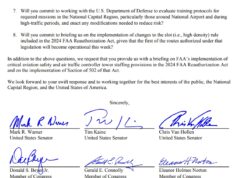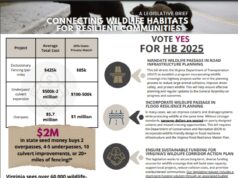More facts and logic on I-66 tolling, this time from State Sen. Dave Marsden, to counter the hysteria we’ve seen from some quarters…
As most of you have probably heard, dynamic tolling has been extended to Interstate 66 inside the Beltway. For the first time, this will allow solo drivers to pay for the privilege of driving on this section of I-66 during peak periods in the morning and the afternoon — which since 1982 have been restricted to high-occupancy vehicles. (5:30 AM to 9:30 AM Eastbound in the morning and 3:00 PM to 7:00 PM in the evening.) This is an increase in tolling and HOV use of 90 minutes in the morning and 90 minutes in the afternoon. The purpose of this tolling is to maximize the use of this portion of I-66 by pulling traffic from nearby corridors; thereby improving the commuting times on Route 50, Route 29 to 11, and perhaps even Route 7. There have been all kinds of overreaction to reports of $40.00 tolls and broken promises from VDOT. Let’s look at this from the standpoint of what is happening as of this morning.
While it is way too soon to predict exactly how rush hour commuters will adjust and take advantage of this added capacity, early reports of disaster have been greatly exaggerated. The average round-trip toll this Monday was $14.50. No one is required to use these toll lanes. It is optional. But what is happening is we are already seeing additional carpools being created to take advantage of the extended hours wherein the road will be restricted to HOV-2 cars and solo drivers paying tolls. HOV is still free. We are also seeing reduced commute times on Route 50 and 29 to 11 — which is one of the goals of opening I-66 inside the Beltway to solo drivers willing to pay the toll.
There are some of my colleagues who believe we should not have done this until we have added an additional lane inside I-66 — which will be completed in two and a half years and that we should have waited for parking capacity for people to expand their carpool use through creating the “slug culture” that exists on I-95. That would have been nice but we don’t have that kind of time on America’s most crowded commuter route.
Some of my colleagues are calling for a shut-down of the tolling for several years until the infrastructure improvements have been completed. I believe this is ill-advised when we can make some improvements now — which will pay for the improvements of the future as we build out the express lanes and the expansion of I-66 outside the Beltway.
Everyone needs to take a deep breath. Toll payers will learn to use I-66 during periods of time when they will not have to pay peak tolls — which will further enhance commuting on nearby roads as they see less traffic. Individuals in the inner suburbs of Falls Church and Arlington will be able to use I-66 for minimal tolls of $0.50 to several dollars — which will further reduce traffic in those already traffic-clogged communities. The one downside has been that with expanding the restricted hours, some people will have to change their commuting patterns and I realize that the changes are inconvenient as these individuals will have to find alternative routes or start paying tolls, but this is a smaller number of commuters than those who will be advantaged by the new tolling arrangement. There are alternative options, however, and they may end up being faster than the amount of time it took them to commute on I-66 during the previous restricted hour arrangement. We just don’t know yet.
Without this project we would not have had not been able to gain the consensus for widening of I-66. We also would not have been able to fund additional parking infrastructure and purchase buses that will make it easier to commute to work in the future – which is what everyone wants.
Let’s give this some time before we begin to criticize it as early indications are that there will be far more advantages than disadvantages. I have included below a report from VDOT — which I encourage you to look at that will further highlight the current position that I am taking.
Happy Holidays to all!
Senator Dave Marsden
66 EXPRESS LANES INSIDE THE BELTWAY TOLL DAY ONE ANALYSIS
Data from Monday commute shows faster commutes on I-66 and
average round trip of $14.50 round-trip
FAIRAX –After nearly four full days of Express Lanes on I-66 Inside the Beltway being underway, the Virginia Department of Transportation reports that morning and afternoon commutes on Monday, Dec. 4, were faster than the same time last December. The average round-trip toll price during peak hours was $14.50, with the average morning toll during peak hours of $10.70 and average afternoon toll during the peak hours of $3.80. This toll rate during peak hours is lower than the estimated average toll rate of $17.00 during peak hours discussed in 2015, as shown in the table below.
Eastbound (AM)
Westbound (PM)
Daily Total
September 2015 Estimate
Average Toll (HOV-2+)
$9.00
$8.00
$17.00
December 4, 2017
Average Toll (HOV-2+)
$10.70
$3.80
$14.50
Further analysis of the Monday morning rush hours indicates the following:
· A total of 13,473 vehicles used I-66 Inside the Beltway between the hours of 5:30-9:30am;
· Of this total 5,082 or 38 percent were carpoolers who traveled free;
· Only 39 vehicles, or 0.29 percent, paid the posted highest toll of $34.50;
· 34 percent of vehicles paid less than $10; and,
· Travel times were 10-12 minutes compared with 15-30 minutes last December.
Further analysis of the Monday afternoon rush hours indicates the following:
· A total of 16,307 vehicles used I-66 Inside the Beltway between the hours of 3:00-7:00pm;
· Of this total 4,964 or 30 percent were carpoolers who traveled for free; and,
· Travel times were 10-12 minutes compared with 10-20 minutes last December.





![Rep. Don Beyer (D-VA08) on “reports of the devastating effects Donald Trump’s Project 2025 agenda would have on [Metro]”](https://bluevirginia.us/wp-content/uploads/2024/10/trumpmetro-238x178.jpg)






![Saturday News: “Trump’s latest tariff TACO probably won’t make your life more affordable”; “The Epstein Email Cache: 2,300 Messages, Many of Which Mention Trump”; “[MTG] questions if Trump is still the ‘America First’ president”; “Jim Ryan tells all: ‘What did the Governor know, when did he know it?’”](https://bluevirginia.us/wp-content/uploads/2025/11/montage1115-100x75.jpg)
